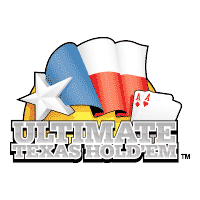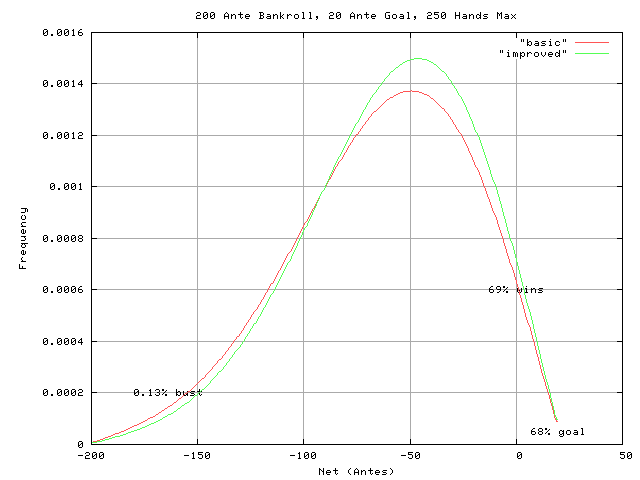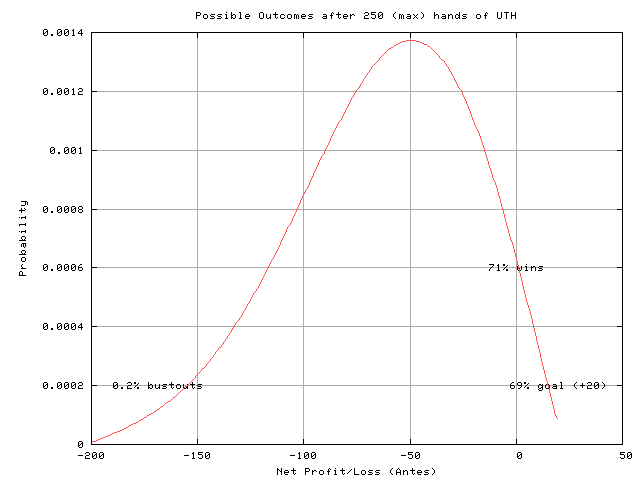Bad Beat Bonus @ Ultimate Texas Hold’Em
 A reader recently asked about the new two-way Bad Beat Bonus in Ultimate Texas Hold’Em. It’s pretty easy these days to crunch out the numbers, so I took an hour to work this one out. After all, I might see the bet somewhere, and I’m becoming a sucker for bonus bets lately 🙂
A reader recently asked about the new two-way Bad Beat Bonus in Ultimate Texas Hold’Em. It’s pretty easy these days to crunch out the numbers, so I took an hour to work this one out. After all, I might see the bet somewhere, and I’m becoming a sucker for bonus bets lately 🙂
Well, at a 14.8% house edge, I’ll probably look for a better paytable before I play this bet. Has anyone seen any other paytables out there?
| Losing Hand | Frequency | Probability | Payout | Return |
|---|---|---|---|---|
| Royal Flush | 0 | 0.000000% | 0 | 0.000000 |
| Straight Flush | 10,300,592 | 0.000370% | 7500 | 0.027776 |
| Four-of-a-Kind | 471,040,512 | 0.016935% | 500 | 0.084677 |
| Full House | 8,435,225,376 | 0.303275% | 50 | 0.151637 |
| Flush | 19,434,208,592 | 0.698725% | 30 | 0.209618 |
| Straight | 18,271,076,976 | 0.656907% | 20 | 0.131381 |
| Three-of-a-Kind | 64,049,759,448 | 2.302804% | 9 | 0.207252 |
| Two Pairs | 399,099,149,640 | 14.348956% | -1 | -0.143490 |
| One Pair | 1,366,512,556,968 | 49.130722% | -1 | -0.491307 |
| High Card | 791,967,420,480 | 28.473892% | -1 | -0.284739 |
| push | 113,130,263,816 | 4.067413% | -1 | -0.040674 |
| Total | 2,781,381,002,400 | 100.0000% | -0.147868 |
Ultimate Texas Hold’em Arrives @ Barona
Finally, months after they sent out the “coming soon” mailers, UTH hits the floor at Barona, and it looks pretty good. They’re dealing it in the chipless (iTable) pit, which has some plus and minuses compared to the standard felt game. The only disadvantage of the iTable is that you will never get a dealer mispay, which can be a very significant component of the game, depending on where you play. (The last few times I played at Harrah’s Rincon, I’ve received a $55 mistake in each session. Instead of killing my 4x losing hand, the dealer paid it as a winner, which is a $55 difference for a $5 Ante bet. That +1100% payout goes a long ways against a 2.3% house edge.)
On the other hand, there are a few pluses to the Barona game. First, everyone is playing their hand face up, like they allow in their Mississippi Stud game. As I’ve written about in this blog, that’s worth about a 0.5% reduction in the house edge. Better yet, the Barona Trips paytable is the 9-7-4-3 type (9 for full house, 7 for flush, 4 for straight), which has a very small house edge of 0.9%. (All the other casinos in San Diego have the 8-6-5-3 paytable, which has a 1.9% house edge.) The game also goes quite a bit faster, since the iTable reads all the hands instantly, and makes the correct payouts. Also, I believe they’re able to open up as many UTH tables as they need in the iTable pit, whereas you can easily be locked out of the only UTH table at Viejas, or the two tables at Harrah’s Rincon and Pala. And, the Barona game is only a $5 Ante, even on weekend nights. Since it’s an iTable game, you can also bet $6, $7, etc. (does not have to be multiples of $5). That’s the only amount of pressing that I’m comfortable with 🙂
Updated Ultimate Texas Hold’Em Practice Game
I’ve re-written the Ultimate Texas Hold’Em practice game in Flash to make it more presentable and enjoyable. I’ll be improving it over the next few days, so most of the features will be added soon. I’ll link this game into my main Ultimate Texas Hold’Em Page, and it’ll eventually replace the old Java game. Enjoy!
Betting Bottom Pair on Flop (UTH)
In Ultimate Texas Hold’Em (UTH), I wondered if it was ever worth checking bottom pair on the flop (basic strategy says to 2x bet), given other player hand info. E.g., if none of the other 5 players paired the board, should you check bottom pair? I ran simulations to compare the value of 2x betting bottom pair, vs. checking on a 6 player table.
| Total table board hits (excluding bottom pair) | ||||||
|---|---|---|---|---|---|---|
| 0 | 1 | 2 | 3 | 4 | 5 | 6 |
| +10% | +15% | +20% | +25% | +30% | +35% | +40% |
This shows that even if no one else hits middle or top pair on the board (i.e., players are holding 10 cards that don’t hit middle or top board cards), it’s still worth 10% of the Ante to 2x bet bottom pair on the flop, compared to checking. It was useful to see these results, because it shows the value of the other players hitting the board, as expected. I wasn’t sure about betting bottom pair when everyone else missed, but the simulations show its still a good bet.
Collusion Performance for Ultimate Texas Hold’Em
I finally got around to simulating the effects of player collusion in Ultimate Texas Hold’Em. Implementing preflop collusion, and the improved 2nd nut kicker and 3rd nut kicker strategies, the house edge is reduced from 2.2% to 1.6% for 6 players. While this is a small average gain, the real benefit comes from the reduced variance gained by not raising marginal hands when copied with other players.
By checking marginal copied hands, the session outcome distribution improves as shown below. Assuming a bankroll of 200 Antes, a goal of 20 Antes, and a maximum session length of 250 hands, the improved strategy reduces the probability of busting out from .20% down to .13%. The probability of reaching your 20 Ante win is reduced from 69% to 68%, but the distribution for the in-between cases improves as shown.
[Note: the low-variance strategy used for the distribution does not raise any basic strategy preflop checking hands; it is designed to minimize variance, and simulates at 2.2% house edge.]
3rd Nut Kicker on Paired Board (UTH)
I looked a little deeper into the case of calling (1x bet) on the river with 3rd nut kicker against a paired board. Basic strategy (i.e., no other info known) says to call this hand. However, by taking into account how much the other players have “hit” the board, you can improve this decision. Similar to the 2nd nut kicker on an unpaired board analysis, the decision comes down to how many total “good” cards the players hold, relative to the table size. The table below provides an advanced strategy of when to call with 3rd nut kicker given easily obtained table info. A “good” player card is anything that hits the board, or 2nd nut kicker or better.
| players | total player board hits & kickers | notes | ||||||
|---|---|---|---|---|---|---|---|---|
| 0 | 1 | 2 | 3 | 4 | 5 | 6 | ||
| 6 | -25% | -15% | -5% | +5% | +20% | +30% | +45% | fold if ≤ 3 good player cards |
| 5 | -12% | -5% | +6% | +17% | +28% | +42% | +54% | fold if ≤ 2 good player cards |
| 4 | -4% | +5% | +17% | +27% | +38% | +49% | fold if ≤ 1 good player cards | |
| 3 | +5% | +15% | +25% | +35% | +45% | always call | ||
| 2 | +13% | +23% | +33% | always call | ||||
| 1 | +22% | always call | ||||||
Practically, this advanced strategy is very intuitive, and you’ll find it agrees with your experience. When no one hits the board, or even has a playable kicker, your chances of winning with a minimum kicker go down considerably. However, when everyone hits the board, sometimes multiply (e.g., full house), your chances increase considerably. The table above quantifies this effect, and shows you the relative strength of your hand for the range of scenarios.
Overall, you’ll find the 3rd nut kicker on a paired board decision comes up about 2.5% of the time. While it’s not really frequent, it’s a decision that most players mull over. Knowing the advanced strategy will help you make your final decision quicker, and with more confidence.
Session Outcome Distributions for UTH w/ Trips Bet
Last night while playing Ultimate Texas Hold’Em, I finally decided to play the Trips bet every hand, just for the fun of it. I played for a few hours, and left while I was winning about $20. (Most of that was due to two dealer mistakes, where I pushed against the dealer hand, but they paid my Blind bet anyways.) Anyways, if I only play a few hours, its worth it to play the Trips bet, since it adds to the camaraderie of the table. The dealer also seems to care more about you when you bet the Trips (probably because that’s when they get toked). I figured the Trips bet adds to the variance of the game, but I calculated the session outcome distribution for 100 hands just to make sure:
Yep, more variance, more cost, and more fun.
Online Ultimate Texas Hold’Em Practice Game
Finally, you can now play Ultimate Texas Hold’Em online with my new practice game. The main purpose of this game is to allow people to practice different betting strategies, and to learn for free. Learning UTH in the casino can be very costly, since most people don’t bet their hands like they should. I put in basic strategy hints in the game which gently suggests when to bet.
Click on the screenshot below to play the game:

Or you can still play the older but simpler and faster Java game (check that you have Java 1.6):
Session Outcome Distributions for Ultimate Texas Hold’Em
The most common mistake players make in UTH is to not bet their hands, especially preflop (i.e., raising 4x according to basic strategy). Certainly, if your initial bankroll is small, like 20 Antes, it’s clear that if you quickly lose three 4x raises, then you’re out. On the other hand, you can just as easily double up for a nice hit-and-run.
I’ve calculated the probability distributions for a few session scenarios, given 1) starting bankroll, 2) hit-and-run goal, and 3) maximum number of hands (session length). These distributions are calculated using basic strategy, i.e. betting a hand whenever long-term advantageous. Hopefully, these scenarios will help you understand the possible outcomes of your sessions, and their likelihoods.
100 Ante Bankroll, Leave if Double-Up or Bust-Out, 100 Hands Max
Let’s say you sit down with a bankroll of 100 Antes (i.e. $500 for a $5 Ante game). You decide before hand that you’ll play a maximum of 100 hands (about 3 hours), and that you’ll leave if you double up (+$500 profit), or bust out. In this scenario, you have an equal chance (1.5%) of busting out or doubling up. Otherwise, 97% of the time you’ll end up somewhere in-between, following the distribution below:
20 Ante Bankroll, Leave if Double-Up or Bust-Out, 100 Hands Max
In this example, say you have only 20 Antes (i.e., $100 total bankroll for a $5 Ante game). You plan to leave if you double-up or bust out, and to play a maximum of 100 hands (~ 3 hours). In this scenario, you’ll have a 33% chance of busting out, a 27% chance of doubling up, and a 40% chance of falling somewhere in-between, following the distribution below:
200 Ante Bankroll, Leave if Win 20 Antes or Bust-Out, 250 Hands Max
Say you have a big bankroll, are happy to hit-and-run after winning 20 Antes (i.e., $100 in a $5 Ante game), and are willing to grind out 250 hands. In this case, you have a 69% chance of making your $100, an overall 70% chance of winning, and only a 0.2% chance of busting out. The remaining 30% of the time, you’ll fall somewhere in-between, according to the following distribution:
Playing “Forever” for 0.8 Antes/hr
Personally, my only goal is to play UTH “forever” and lose (2.3% Ante/hand)(35 hands/hr) = 0.805 Antes/hr. For a $5 Ante game, that’s only a cost of $4/hr. I consider that cheap entertainment, and Casino Pauma gives back more than that in player rewards and cashback. There, your only effective costs are your dealer tokes.
Still, there’s always the risk of running bad, and busting out a limited bankroll. (And the equal chance of running good and doubling your entire bankroll, or hitting a Royal Flush, and becoming a “lifetime winner” for a while). I computed an outcome distribution over 3000 hands, starting out with a 500 Ante bankroll (i.e., $2500 for a$5 Ante game), and adding back $4/hr to your bankroll (either from cashback, or chalking it up to cheap entertainment). For this scenario, there’s still a 3.5% of busting out, and a 3.5% chance of doubling-up. Otherwise, 93% of the time, you’ll end up somewhere in-between according to the following distribution:
Conclusions
The probability density function of the outcome of a single basic strategy UTH hand was calculated, and used to compute the session outcome distribution for a scenarios of bankrolls, goals, and session times. In each scenario, the simulated 2.3% Ante/hand house edge is seen, no matter the shape of the distribution.
2nd Nut Kicker on Unpaired Board (UTH)
A lot of times when playing Ultimate Texas Hold’em, you’ll be faced with a 1x river call with a bare minimum kicker. It probably occurs to you that the strength of your call depends on how much of the board the other players have hit. For example, say you’re looking at 1x calling an unpaired board with 2nd nut kicker. Basic strategy says to call if it’s not a scare board, nor gutshot board, and there’s no possible flush on board, or if both your kickers play. (This situation occurs 1.3% of the time if you play basic strategy, and more frequently if you play less aggressively than basic strategy.) Your odds are better if the players at the table connected with the board (made a lot of pairs) than if everyone missed. I ran some simulations to quantify this effect, to show how you can use table information to improve this call.
| total players |
total pairs | notes | ||||
|---|---|---|---|---|---|---|
| 0 | 1 | 2 | 3 | 4 | ||
| 2 | +1.3% | +11% | +17% | always call | ||
| 3 | -3.4% | +5.3% | +12% | +21% | +33% | fold if no pairs |
| 4 | -5.3% | -0.0% | +7.8% | +16% | +26% | fold if < 2 pairs |
| 5 | -16% | -5.8% | -1.4% | +11% | +21% | fold if < 3 pairs |
| 6 | -28% | -16% | -4.7% | +4.9% | +14% | fold if < 3 pairs |
So, for example, say you have Jh 2s and the board is Ah Ks Th 9d 3s. With no more information, the odds are that you should call (+19.1%). However, if you’re at a full table (6 players), and all the other players only made 2 pairs with the board, then you should fold. The percentages of the table don’t exactly apply to this specific case, but are averages over 20 million hands, and all cases where basic strategy said to call with 2nd nut kicker.








7 comments